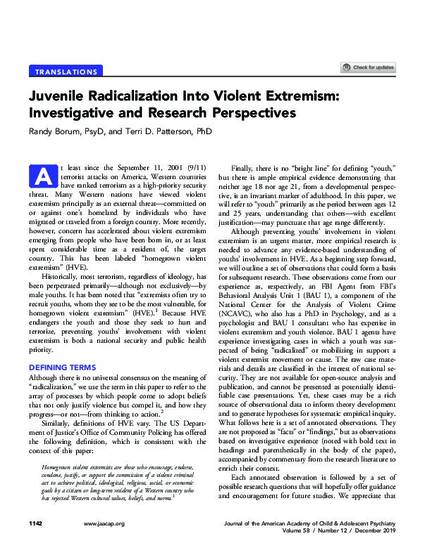
Article
Juvenile Radicalization Into Violent Extremism- Investigative and Research Perspectives.pdf
Journal of the American Academy of Child & Adolescent Psychiatry
(2019)
Abstract
Although preventing youths’ involvement in violent extremism is an urgent matter, more empirical research is needed to advance any evidence-based understanding of youths’ involvement in HVE. As a beginning step forward, we will outline a set of observations that could form a basis for subsequent research. These observations come from our experience as, respectively, an FBI Agent from FBI’s Behavioral Analysis Unit 1 (BAU 1), a component of the National Center for the Analysis of Violent Crime (NCAVC), who also has a PhD in Psychology, and as a psychologist and BAU 1 consultant who has expertise in violent extremism and youth violence. BAU 1 agents have experience investigating cases in which a youth was suspected of being “radicalized” or mobilizing in support a violent extremist movement or cause. The raw case materials and details are classified in the interest of national security. They are not available for open-source analysis and publication, and cannot be presented as potentially identifiable case presentations. Yet, these cases may be a rich source of observational data to inform theory development and to generate hypotheses for systematic empirical inquiry. What follows here is a set of annotated observations. They are not proposed as “facts” or “findings,” but as observations based on investigative experience (noted with bold text in headings and parenthetically in the body of the paper), accompanied by commentary from the research literature to enrich their context.
Keywords
- juvenile radicalization,
- adolescent radicalization,
- violent extremism,
- terrorism,
- adolescent,
- juvenile
Disciplines
Publication Date
2019
DOI
10.1016/j.jaac.2019.07.932
Citation Information
Borum, R., & Patterson, T. D. (2019). Juvenile Radicalization Into Violent Extremism: Investigative and Research Perspectives. Journal of the American Academy of Child and Adolescent Psychiatry, 58(12), 1142-1148.
